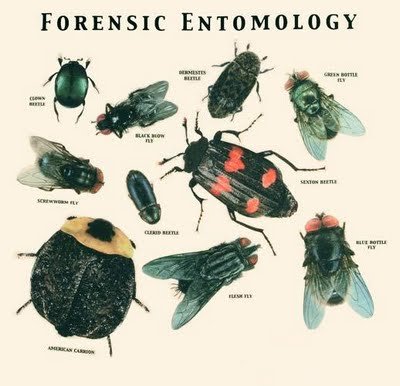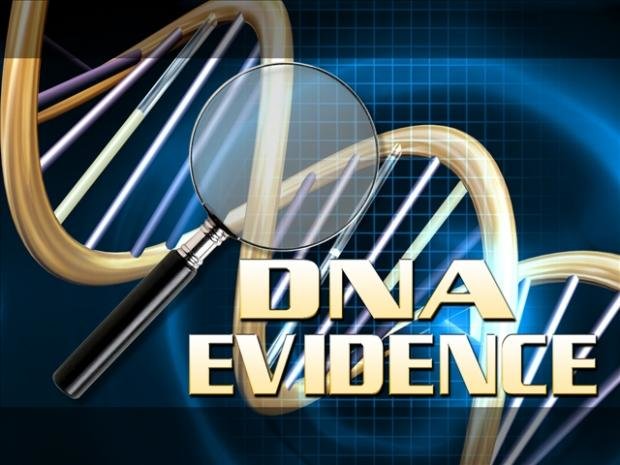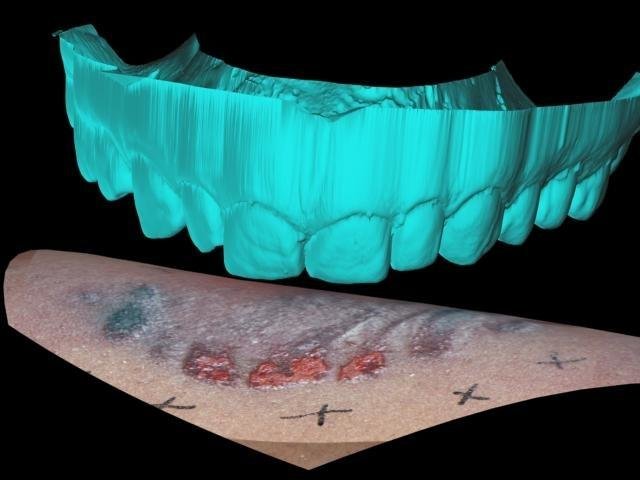
Forensic entomology is the biological use and study of insects and arthropods that inhabit decomposing remains in order to aid legal investigations in criminal matters (in rare cases, it can also deal with non-decomposing insects). Typically, forensic entomology is associated with death investigations, however it’s also applied to civil and other criminal components non-related to homicides. Thus, forensic entomology can be broken down into three general areas of interest: medicolegal, urban and stored products pets.
Death can be defined as the physical shut down of bodily and brain functions, and is officially determined when all of the body’s biological functions are inert. Shortly after death, the body begins to cool and biological tissue starts to stiffen until it becomes hard – this is called rigor mortis. After all the cells in the body stop functioning, the body’s decomposition process starts as bacteria breaks down protein, lipids and various other organic compounds in the body.
There are five stages of human decomposition:
- initial decay. The corpse starts to decay internally – however from the outside it looks normal.
- putrefaction. This is the stage where the corpse begins to smell, as gas swells the body and flesh begins to decay.
- black putrefaction. The gas pressure increases to the degree that it causes the body to collapse and the gas to escape, intensifying the odor. The flesh, now in an more advanced state of decay, turns a to a creamy white and exposed parts blacken, hence the term.
- butyric fermentation. The corpse dries out.
- dry decay. The last stage of human decomposition find the corpse almost completely dried out, with bones exposed and with a dramatic slow down of the rate of decay.
If a body has been dead for quite some time, forensic entomologists use the presence and life cycles of Calliphoridae (flies) and Coleoptera (beetles) on the body to help determine time of death. Examining the life cycle of blow flies and beetles on the body as well as the environment around the body (i.e. weather, temperature, precipitation, etc.) that might affect those insects is one of the best ways of estimating a time of death.
Typically, the time of death can be established by checking the temperature or grade of rigor mortis, but this only works recently deceases. To determine the time of death for a corpse already in decay, forensic entomology comes in great utility. Forensic entomology studies a slew of insects, however as far as death investigations are concerned, the main interest is directed towards necrophagous (corpse-eating) insects. The most common of such insects are the blow flies and beetles, and for the sake of simplicity, only these two will be discussed further. For a more extensive look, please study a more comprehensive resource.
The Study of Blow Flies
Just minutes after death, blow files begin to lay sacks of up to 250 eggs through the body’s orifices, such as the mouth, nostrils, genitals, any kind of open wound and so on. Within 24 hours, these eggs hatch into larvae or “maggots” – this is called the first stage. As they feed they molt into second-stage maggots and after several hours molt into third-stage maggots. If there are a significant number of third-stage maggots feeding on the body it can cause the body’s temperature to rise.
After the maggots are done feeding on the corpse, they will begin to migrate away from it and enter the pupal stage. These blow flies pupae typically resemble rat droppings or cockroach egg cases, which often causes them to be overlooked by crime scene investigators – big mistake, since they signify an extremely important stage for forensic entomologists. If the adult insect has yet to emerge, the pupa will appear featureless and rounded on both sides. If the adult insect has emerged, one end will appear cut off and at a closer inspection its hollow interior can be observed. Adult blow flies are easily recognizable by their metallic green or blue appearance.
Forensic Entomology Study of Beetles
The beetles are one of the largest groups of animals, order Coleoptera. Like the blow flies, beetles also undergo development, with larvae appearing sensibly different form the adult form. An untrained eye might confuse the blow fly maggots with the beetles larvae, since they look very much alike, however it’s worth nothing that beetle larvae vary greatly from one species to another. The main difference between beetle larvae and maggots found on decomposing bodies is that the the first have 3 pairs of legs, while the latter doesn’t have any. The bodies of beetle larvae may range from almost white, robust, and hairless to dark brown, slender, and quite hairy, while other may appear black or with armor plates on their back.
Insects recovered from decomposing bodies are of great use to toxicological analysis. While the insects are very fast in devouring the decomposing remains of a body, the same chemicals in the body will be found in the insects themselves, as they’ve also ingested them. Thus, it’s fairly easy to recover insect larvae for toxicological analysis, since insect larvae tissue assimilates drugs and toxins that accumulated in human tissue prior to death.



